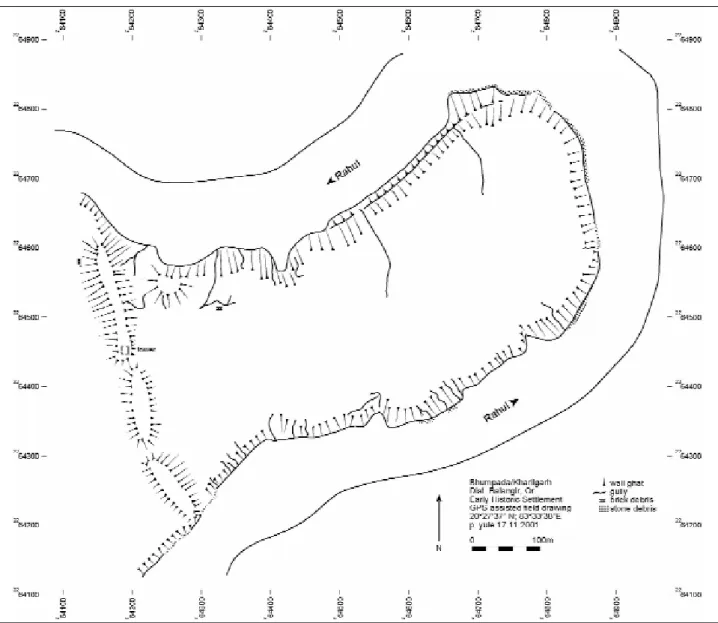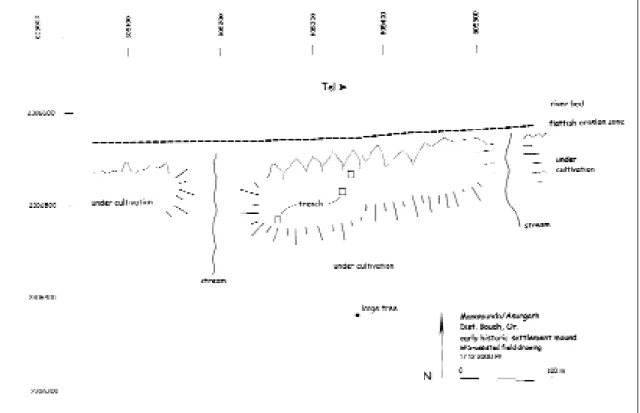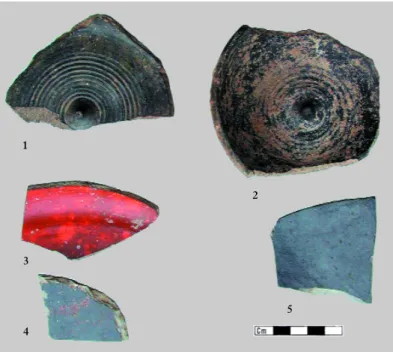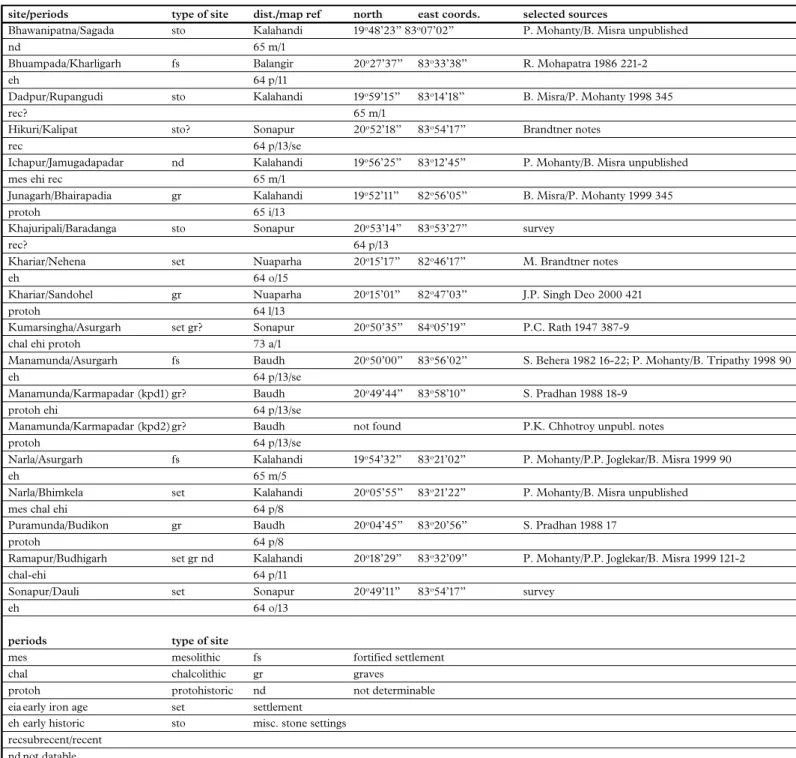Fig. 1 – Sites referred to in western Orissa.
Western Orissa
(November - December 2000):
Preliminary Report of a Survey
M . B R AND TN ER , B . M IS R A, P. MO H A NTY & P. YU L E
I n t r o d u c t i o n
Archaeological research during the 1980s in Orissa revealed on the one hand great potential for new knowl- edge, on the other, neglect relative to other parts of India.
Even into the 1980s few usable publications existed for the archaeology of the region between coastal Orissa and the Vidarbha region toward Nagpur.1More particularly, numerous, haphazard, and repetitively published site lists provide little real information, and all of western Orissa as well as the Chhattisgarh region (some 220,000 km2) remain archaeologically terra incognita. This includes the area known in antiquity as DakÒina Kosala as well as the adjacent land in northern Andhra Pradesh, that is all of eastern Central India. For prehistoric and protohistoric artefactual parallels in this area one must turn toward the western part of India, where vastly more research has taken place.
The main category of lower peninsular iron age India, including so-called megalithic sites, seems little repre- sented in Orissa.2 The term “megalithic” is frequently misused in India and elsewhere to designate any rustic structure constructed of stones, and in practice includes diverse undated monuments. While the classic south Indian iron age manifests in itself Orissa in large part in terms of pottery, this is far less the case with its charac- teristic burial structures. In absolute years, this age is rep- resented by rare “chalcolithic” sites such as the latest (IIb) phase of coastal Golabai (Dist. Khurda) and Kameswaripali (Dist. Sonepur). But in western Orissa, the remains as yet provide little basis for a chronology.
Moreover, the absolute chronology is far less certain than the relative one, so that the temporal overlap between chalcolithic and iron age, for example, remains unstruc-
tured. Classic archaeological manifestations of early his- toric India, such as Northern Black Polished Ware (NBP) are regretably lacking in the area. The interface of the so-called iron age and early historic periods in west- ern Orissa forms the basis of our inquiry (Fig. 1).
State of Research
Two geographic areas must be highlighted at the out- set: First, western Orissa contains a broad spectrum of monuments dating into the medieval period which only recently have become known. Not unexpectedly, in neighbouring Chhattisgarh, a new study reveals a con- centration of iron age tomb structures immediately adja- cent to our working area.3Our colleagues in the interior of Orissa, B. Misra and P. Mohanty, have culled only surface finds from there and chronology rests solely on external comparisons. This holds also for the continued efforts of J.P. Singh Deo (yuvarajaof Khariar) and his antiquarian-interested colleagues, who in fact do obtain interesting strayfinds. But archaeologists often overesti- mate the range of their method in interpreting such sur- face and other stray finds, for lack of good excavated ones. The authors strive to rise above a merely antiquar- ian amateurism, limited in its historical range, and put the archaeology on a sounder footing.
A good step ahead for the archaeology of Orissa is a new anthology, recently published by K.K. Basa and P. Mohanty, which contains several substantial articles which bring the archaeology of Orissa further than one essentially of local interest. In particular, one new contri- bution on the archaeology of Baudh (interior Orissa) dis- trict contains hitherto unknown sites of different periods
and is relevant to our work.4It also updates our knowl- edge of the pottery of the region.
Coastal Orissa shows some progress in dating the pro- tohistoric pottery, although till now their publication does little more than highlight attractive finds. South of Lake Chilka recently some sites yielded fragments of early his- toric fine black and red ware. While the coastal variety is coarse, that of the interior is fine5– which provides a hint of a new picture of the iron age and early historic periods other than the present one.
Since the archaeology of Orissa rests principally on surface finds and those excavated without documenta- tion, it supports only the most superficial archaeological interpretation. Site plans are neither published, or are published in such a way that they are of little use regard-
ing the size, date, or importance of a given place. Often one experiences unreflected adherence to obsolete chronological notions and regional patriotic beliefs, such as N.K. Sahu’s interpretation of Narla/Asurgarh as an A†avi stronghold against Akoka and 600 years later the fort of Vyaghraraja.6
Research Goal
The central topic of the Indian-Kiel work group is to elucidate the polycentric nature of sub regional and hege- monial identity in historic Orissa. In this context the wide- spread modern centric perception of interior Orissa as peripheral, as opposed to the coastal area, is challenged.
Fig. 2 – Profile and plan of an iron age tomb in Khariar/Sandohel.
Sites Surveyed in 2000
We concentrated our research resources in the field on eight sites which illuminate the late proto- and early historic culture of western Orissa, but registered other (Table 1). In addition, we surveyed for unknown sites.
The following sites commanded our attention:
1- Khariar/Sandohel (Dist. Nuaparha 20°15’01”N;
82°47’03”E)7(Fig. 2)
In 1998 students from Khariar college excavated a site which in the late 1980s was identified as an iron age
“megalithic” grave.8Without documenting the site, they destroyed it. The finds said to come from here are a mix- ture of iron age pottery and iron finds, the provenance of
which is uncertain. They are stored in a cardboard box in the college. The grave circle nearly 7 m in outside diam- eter.
2- Manmunda/Karmapadar (Dist. Baudh 20°49’44”N; 83°58’10”E)9(Fig. 3)
Close to each other lie mounds, possibly a destroyed dolmen, and several stone circles of uncertain date.
Karmapadar (Karumpadar) lies on the south bank of the Tel/Mahanadi and east of present-day Sonepur. Visible remains spread over 3 or 4 ha. The surface finds are largely chalcolithic and iron age sherds. Of special inter- est are fragments of a four-legged vessel with its form- parallels from chalcolithic and iron age sites in Central and South India.
Fig. 3 – Plan Manmunda/Karmapadar.
3- Bhuampada/Kharligarh (Dist. Balangir 20°27’37”N; 83°33’38”E)10(Fig. 4)
One of the key sites for our line of inquiry is the early historic Kharligarh at the confluence of the Rahul and the Tel, owing to its large size (17 ha intra muros). Lying above the steep banks of the Rahul, it is easy to defend and, owing to its position at the confluence of the two rivers, is strategically important as well. For trade, this river settlement is favourably located, offering the pre- requisites for an urban settlement. Possible fortifying of the river bank exists. Architectural ruins are visible on the surface, especially baked bricks and dressed stone.
4- Manmunda/Asurgarh (Dist. Baudh 20°50’00”N;
83°56’02”E)11(Fig. 5)
This badly eroded settlement appeared to others and initially to us as having potential for excavation, owing to the chronologically diverse and qualitatively good surface finds. It offers a broad spectrum from the neolithic/chal- colithic to at least the early medieval period – thus span- ning more than 2000 years. Possibly only the south wall still exists, the other three evidently having been eroded by the Tel. This explains the lack of structures in the unpublished excavations at this site. Colleagues from Sambalpur University have conducted several seasons of
Fig. 4 – Plan of Bhuampada/Kharligarh and profile of the rampart.
excavation here. This site proved smaller than originally reported: 340 m long instead of 1200 m, perhaps partly due to the effects of erosion, or a different manner of des- ignating the anthropogenic remains. Handmade pottery shows post-firing painted decoration. Knobbed ware indicates the early historic presence of Buddhist monks who made and used such vessels.
5- Ramapur/Budhigarh (Dist. Kalahandi 20°18’29”N;
83°32’09”E)12(Fig. 6)
Over 3 ha in size, this site attracted the attention of B.
Misra and P. Mohanty, owing to a scatter of iron age and early historic pottery sherds. Building remains are under- standably difficult to confirm without excavation.
Notable is that at this site for the first time in Orissa, Northern Black Polished Ware is confirmed (Fig. 7), thus correcting an old error which has been uncritically repeated in the archaeological literature.13 This excel- lently made pottery nota benederives from the so-called western Orissa “periphery”, and not from the coastal strip. Again, imported knobbed ware, bearing owner’s marks indicates the presence of early historic Buddhist monks (as also at Manmunda/Asurgarh). Other luxury goods are in evidence: for instance, fragments of an ivory comb, seals fashioned from jasper, one bearing the sym- bol of the “tree in railing” motive of Mauryan and Post- Mauryan punch marked coins), another jasper seal with
Fig. 5 – Plan Manmunda/Asurgarh.
a problematic inscription, a jasper earring, a double shell mould for casting either metal beads or rivets. Aside from this, numerous beads fashioned of semiprecious stones derive from this site, as also especially from Narla/Asur- garh which we shall turn to now.
6- Narla/Asurgarh (Dist. Kalahandi 19°54’32”N;
83°21’02”E)14(Fig. 8-9)
30 km north-east of Bhawanipatna, near Narla, a rec- tangular fortification, measuring 500 µ 400 m with an entrance on each side, encloses early historic settlement remains, now under protection by the ASI. The ramparts measure 11 m in height, and up to 50 m in width. While this site has been known from some time (Fig. 8), neither epigraphic nor literary sources have yielded its ancient name. Its appearance has been obscured by grotesquely distorted maps. N.K. Sahu’s suggestion that it in fact is the fort of the Vyag h r a raja king Mahakan tara, mentioned in the Allahabad inscription of Samudragupta) cannot be verified. Nor can his assumption be confirmed that it is the A†avi stronghold (that of the forest dwellers) that the Kalingan army, which Akoka throunced, were recruited from this area and that after battle they retreated here.
In 1958 a hoard of 539 pre-Mauryan, Mauryan, and Post-Mauryan silver punch marked coins are said to have come to light here accidentally. Excavation (Sambalpur University) followed in 1973. The pottery thereof is not recorded stratigraphically, and therefore eludes strati-
graphic analysis. Aside from the pottery, to judge from the quantity and quality of the finds, an active bead industry is in evidence.
7- Lokapada hoard of 300 punch marked coins Dist.
Balangir (20°49’40”N; 83°36’42”E)15
From the banks of the Suktel, the police confiscated the bulk of the c.800 coins around 1990. But about 1/3 of them are said to have been melted down on their dis- covery. This hoard have not been studied, but at least a part of them are certainly Mauryan in date.
8- Junagarh/Bhairapadia (Dist. Kalahandi 19°52’11”N; 82°56’05”E)
The isolated presumed “megalithic” tomb lies in a copse near the town of Bhairapadia. Small finds are not visible on the surface. Nonetheless this is one of the clear- est examples of an early megalithic circle in the western part of Orissa. Since we began studying the distribution, the evidence regarding the iron age in the area has mounted (see supra). Till now one could only assume that stone enclosures and similar relicts were “mega- lithic” iron age graves and not the recent megalithic prac- tices of Ghond and other tribals. The publication of megalithic stone alignments in nearby Chhattisgarh strengthens the reasonable assumption that megalithic structures also were present in neighbouring Orissa.
D i s c u s s i o n
The rarity of iron age megalithic graves in Orissa’s back country may well be due to the ubiquitous destruc- tion of such structures (as demonstrable at Karkabhat in Chhattisgarh and at many other Indian megalithic sites)16 and/or to the weak state of research. To complicate mat- ters, to this day so-called menhirs and stone circles still are erected, reused, and worshipped. We can do little more than acknowledge their existence without being able to establish their age. A main goal is to investigate iron age burial practices, optimally in a cemetery in order to define this temporal horizon locally. The correlation of settlement and burial finds with each other would also serve to put the chronology on a firmer footing.
A second project-emphasis is to investigate the early historic fort horizon, incipient urbanisation, and state
Fig. 7 – Knobbed Ware (1-2) and Northern Black Polished Ware in different colours (3-5) said to come from Rampur/Budhigarh.
1
2
5 3
4
Fig. 8 – Plan of Narla/Asurgarh.
Fig. 9 – Plan and profile Narla/Asurgarh.
formation along the Tel/Mahanadi. From the Mauryan Period, that is 4th-3rd centuries BC, several sites reveal finds that show contact with the Ganges area as well as with Orissa‘s coastal region. Over time, gradually the latter are acculturated, taking on properties of the Gangetic sites. This holds for settlements along the Tel and its back country. Such sites include those just discussed: Budhigarh, Kharligarh, Narla/Asurgarh as well as others which we surveyed. The contexts and their
finds show characteristic signs of urbanisation. These include a large settlement area, elaborate fortifications, baked brick architecture, coinage, seals with script, imported luxury ware and with it, evidence for trade, not to forget indication of Buddhist enclaves which at this time are related to urban and mercantile settlements.
In addition to the large settlements, small ones exist in river ghats, revealed by erosion. Herewith the first ele- ments of a settlement hierarchy come to fruition which
nd 65 m/1
Bhuampada/Kharligarh fs Balangir 20°27’37” 83°33’38” R. Mohapatra 1986 221-2
eh 64 p/11
Dadpur/Rupangudi sto Kalahandi 19°59’15” 83°14’18” B. Misra/P. Mohanty 1998 345
rec? 65 m/1
Hikuri/Kalipat sto? Sonapur 20°52’18” 83°54’17” Brandtner notes
rec 64 p/13/se
Ichapur/Jamugadapadar nd Kalahandi 19°56’25” 83°12’45” P. Mohanty/B. Misra unpublished
mes ehi rec 65 m/1
Junagarh/Bhairapadia gr Kalahandi 19°52’11” 82°56’05” B. Misra/P. Mohanty 1999 345
protoh 65 i/13
Khajuripali/Baradanga sto Sonapur 20°53’14” 83°53’27” survey
rec? 64 p/13
Khariar/Nehena set Nuaparha 20°15’17” 82°46’17” M. Brandtner notes
eh 64 o/15
Khariar/Sandohel gr Nuaparha 20°15’01” 82°47’03” J.P. Singh Deo 2000 421
protoh 64 l/13
Kumarsingha/Asurgarh set gr? Sonapur 20°50’35” 84°05’19” P.C. Rath 1947 387-9
chal ehi protoh 73 a/1
Manamunda/Asurgarh fs Baudh 20°50’00” 83°56’02” S. Behera 1982 16-22; P. Mohanty/B. Tripathy 1998 90
eh 64 p/13/se
Manamunda/Karmapadar (kpd1) gr? Baudh 20°49’44” 83°58’10” S. Pradhan 1988 18-9
protoh ehi 64 p/13/se
Manamunda/Karmapadar (kpd2)gr? Baudh not found P.K. Chhotroy unpubl. notes
protoh 64 p/13/se
Narla/Asurgarh fs Kalahandi 19°54’32” 83°21’02” P. Mohanty/P.P. Joglekar/B. Misra 1999 90
eh 65 m/5
Narla/Bhimkela set Kalahandi 20°05’55” 83°21’22” P. Mohanty/B. Misra unpublished
mes chal ehi 64 p/8
Puramunda/Budikon gr Baudh 20°04’45” 83°20’56” S. Pradhan 1988 17
protoh 64 p/8
Ramapur/Budhigarh set gr nd Kalahandi 20°18’29” 83°32’09” P. Mohanty/P.P. Joglekar/B. Misra 1999 121-2
chal-ehi 64 p/11
Sonapur/Dauli set Sonapur 20°49’11” 83°54’17” survey
eh 64 o/13
periods type of site
mes mesolithic fs fortified settlement
chal chalcolithic gr graves
protoh protohistoric nd not determinable
eia early iron age set settlement
eh early historic sto misc. stone settings
recsubrecent/recent nd not datable
Table 1 – Sites studied in 2000 in western Orissa.
we hope to complement as time and methods allow. The finds and contexts within the area selected for investiga- tion bear witness to an intensive and early indigenous process of urbanisation which in these dimensions is not present on the coast. Today Orissa’s back country is con- sidered to be the poorest and most backward in all of India. In light of the present-day economic wealth of coastal Orissa, this interior urbanisation surprises one at first. But consider that in the early Sanskrit literature (for example Kau†ilya’s Arthakastra) the economic impor- tance and in particular the richness of the mineral resources of eastern Central India repeatedly are men- tioned. Moreover, the infrastructural situation is fostered by the fact that this area was linked by important routes to the rest of ancient India. In this respect the coast is less fortunate. Thus seen, interior Orissa’s early prosperity in fact is not at all surprising.
In light of these preliminary findings, one may also review the question regarding Akoka’s motives and mili- tary options, since his conquests are limited to the coast and he left the A†avi land untroubled. A question occa- sionally raised is whether he was preoccupied with the control of sea routes and the protection of the port of Tamraliptiin the Ganges delta from competitors to the South? In any case, in Orissa’s back country Mauryan influence there may have been, but Mauryan presence is
yet a different matter. In other words, “Secondary state formation” could not have taken place here at this time.
Military action in the interior would have overtaxed Akoka’s resources.
Gupta influence seems equally as marginal. Samu- dragupta (c. 335-375 AD), the second Guptan ruler, marched through western Orissa on his great campaign to the South around 360 or 370 AD and conquered several rulers whose names he has left us. These are not mere petty chieftains, but rather princes who already used the legitimatizing power of northern Sanskrit culture: Mahendra from Kosala, Vyag h r a raja from Mahakantara, and Man∂araja from Kuralla. Although the attribution of the rulers named in the Allahabad inscription to the sites which we are dealing with would be premature, one can rest assured that the fortified proto-urban sites mentioned here, with their early rela- tions with North India, link with the military opponents of Samudragupta.
The interface of the prehistoric village megalithic cul- ture with early historic urban culture, which includes the transition from tribal to early state structures, the conti- nuities and discontinuities in the economic-social devel- opment, as well as the cultural orientation of the time between 1000 BC and 500 AD are the subject of our efforts.
N O T E S
1 Recent substantive work dealing with the archaeology of Orissa: P. Yule/A. Haupt- mann/M. Hughes 1989 [1992], 193-275; M.
Brandtner 1994 and 2000; K. Basa/P. Mohanty 2000.
2Cf. B.K. Thapar 1985, map on 105.
3A.K. Sharma 2000.
4B. Tripathy 2000, 392-417.
5 Pottery from Nehena (in the interior): M.
Brandtner 1994, 110, 111 fig. 8a-e.
6N.K. Sahu 1982, 6-7.
7The post “selective availability” readings which are cited at the beginning of each of the sites listed below use the map datum “wgs b84”.
8M. Brandtner 1994, 103 Fig. 8.1b; J.P. Singh Deo 2000, 421.
9S. Pradhan 1987-88, 18-19.
10Anon. [S.K. Mukherji] IndArchRev. 1968-69 [1971] 68 no. 41; R. Mohapatra 1986, 221-2.
11Anon. [S.K. Mukherji], IndArchRev. 1968-69 [1971] 68 no. 42; S. Behera 1982, 16-22;
P. Mohanty/B. Tripathy 1998, 90.
12P. Mohanty/P.P. Joglekar/B. Misra 1999, 121- 2.
13For example, B.K. Thapar 1985, 122 map.
This war is commonly confused with Black Slipped Ware.
14P.C. Rath 1947, 387-389; S. Rajaguru 1950, 243-259; D. Mitra in: A. Ghosh 2 1989, 25; P.
Mohanty/P.P. Joglekar/B. Misra 1999, 90.
15 Personal communication, S.N. Agrawal in Tarbha (Dist. Sonpur). Brandtner pho- tographed some of these coins.
16A.K. Sharma 2000, fig. 18.
Acknowledgements: We should like to thank H . Kulke for initiating the Orissa research project, for sponsoring our work, and the DFG for funding it. In Orissa our special thanks go to K.K. Basa and B.K. Rath for their support in Bhubaneshwar. This note is written up essen- tially as the brief talk upon which it is based, and thus cannot solve the archaeological prob- lems which it registers. If not otherwise noted, P. Yule is credited with the text-figures. Martin Brandtner became ill, and Paul Yule wrote up the text from the expedition papers.
R E F E R E N C E S
Basa, K.K. & Mohanty, P. eds. (2000) Archae- ology of Orissa. Delhi.
Behera, P.K. (2000-2001) Excavations at Khameswaripali – A Proto Historic Settlement in the Middle Mahanadi Valley Orissa: A Pre- liminary Report. Pragdhara11, pp. 13-34.
Behera, S.C. (1982) Manamunda. in S.C.
Behera (ed.), Interim Excavation Reports. Sam- balpur, pp. 16-22.
Brandtner, M. (1994) Archaeology of Western Orissa: Finds from Nehena. South Asian Archaeology 1993. Helsinki, pp. 101-114.
Brandtner, M. (2000) Kalinga und seine Haupt- stadt in frühgeschichtlicher Zeit. Studien zur Geschichtsforschung des Altertums 7. Ham- burg.
Ghosh, A. (1989) Encyclopedia of Indian Archae- ology2 vols. Delhi.
Mohanty, P. & Joglekar, P., Misra, B. (1998-99) Early Historic Investigations in Kalahandi Dis- trict, Orissa: A Preliminary Report. Puratattva 29, pp. 120-131.
Mohanty, P. & Misra, B. (2001) Early Historic Kalahandi. Orissa Revisited, Marg special monograph issue, Mumbai, pp. 17-26.
Mohanty, P. & Tripathy, B. (1997-98) The Pre- historic and Early Historic Cultures of Orissa.
Pragdhara8, pp. 70-98.
Mohapatra, R. (1986) Archaeology of Orissa.
Delhi.
Pradhan, S. (1987-88) Megalithic Remains in the Upper Mahanadi Valley of Orissa. Journal of Ancient Indian History17,1-2, pp. 16-22.
Rajaguru, S. (1950) Annual Report of the Research Assistant for the Year 1947-48.
Kalinga Historical Research Society I I . 4 , pp. 243-259.
Ramachandra Murthy, P. (2000) Megalithic Culture of the Godavari Basin. Delhi.
Rath, P.C. (1947) Notes on Important Archae- oliogical Sites Asur-gada in Sonpur State.
Kalinga Historical Research Society I . 4 , pp. 387-389.
Sahu, N.K. (1982) Asurgarh, in: S.C. Behera, 1-8.
Sharma, A.K. (2000) Archaeo-Anthropology of Chhattisgarh. Delhi.
Sinha, B. K. (2000) Golabai: A Protohistoric Site on the Coast of Orissa, in: Basa/Mohanty 2000, pp. 322-355.
Singh Deo, J.P. (2000), Archaeology of Kala- handi and Nuapada Districts, Orissa, in: Basa
& Mohanty 2000, pp. 418-430.
Thapar, B.K. (1985) Recent Archaeological Dis- coveries in India. Paris.
Tripathy, B. (2000), Archaeology of Boudh, Central Orissa, in: Basa/Mohanty 2000, pp. 392-417.
Yule, P., Hauptmann, A. & Hughes, M. (1989 [1992]) The Copper Hoards of the Indian Subcontinent: Preliminaries for an Interpreta- tion. Jahrbuch des Römisch Germanischen Zen- tralmuseums Mainz36, pp. 193-275.
Yule, P., Rath, B.K. & Hojgaard, K. (2000) Sankarjang: A Metals Period Burial Site in the Dhenkanal Uplands of Orissa, in: Basa &
Mohanty 2000, pp. 285-321.







